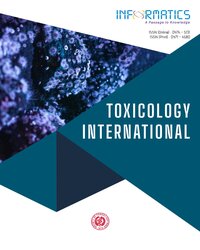Potential Toxic Elements Load and their Health Risk Assessment in Vegetables Grown in Nsukka Area of South-Eastern Nigeria
Subscribe/Renew Journal
Seven potential toxic elements (PTEs) (Cr, Pb, Zn, Ni, Cd, Co, and Fe) were assessed in some selected vegetables collected from Nsukka agricultural areas. Flame Atomic Absorption Spectroscopy was used to determine the Potential Toxic Elements (PTEs). The human health risk evaluation was performed and the average detectable concentration of the PTEs were all within the permissible limit of WHO/FAO. The highest concentration of Cr (0.1750±0.1543) was found in Solanum aethiopicum fruits from Opanda in Uzo-uwani, Pb (0.6667± 0.1443) in yellow Capsicum annuum L. seeds from Opanda in Uzo-uwani, Zn (2.9441 ± 1.7382) in Solanum melongen fruits from Opi-Agu, Ni(0.3761 ± 0.1184) in Gongronema latifolium leaves in Uzo-uwani, Cd (0.0703 ± 0.0316) in Solanum melongen fruits from Opanda in Uzo-uwani, Co (0.0485± 0.0346) in red Capsicum annuum L. seeds from Opanda in Uzo-uwani and Fe (13.2460 ± 1.3633) in Solanum melongen fruits from Opanda in Uzo-uwani. The health risk assessment of the PTEs showed that only Pb has the hazard quotient in children to be above one in Solanum melongen seed of Opi-Agu. However, the health risk associated with the consumption of Cr, Zn, Ni, Co, Cd and Fe were not as high as Pb. The Total Hazard Index (THI) of the PTEs was above 1 for children in Solanum melongen seed, and Solanum aethiopicum leaf. Therefore, the consumption of Solanum melongen fruits and Solanum aethiopicum leaf can be considered not safe for children. Other vegetables assessed did not constitute much potential health risk for both adults and children concerning the HI and HQ evaluated.
Keywords
Capsicum annuum, Gongronema latifolium leaf, Potentially Toxic Elements, Solanum aethiopicum, Vegetables
User
Subscription
Login to verify subscription
Font Size
Information



